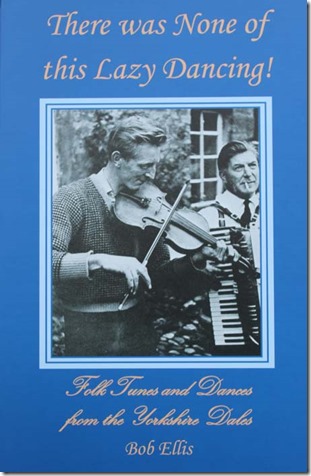 The local musicians who led Dales folk dancing right through the night in the early 1900s are celebrated in a book full of fascinating detail and music published as part of the Yorkshire Dales Folk Dance and Tunes Project at the Dales Countryside Museum (DCM) in Hawes.
The local musicians who led Dales folk dancing right through the night in the early 1900s are celebrated in a book full of fascinating detail and music published as part of the Yorkshire Dales Folk Dance and Tunes Project at the Dales Countryside Museum (DCM) in Hawes.
The author, Bob Ellis of Gayle, has entitled it There was None of this Lazy Dancing, quoting a concertina player, Sam Fawcett of Baldersdale (1878-1960). Fawcett said: “When we get a drop of beer… and got into full blast, there was none of this lazy dancing!” (Pictured on front cover are Peter and Jackie Beresford.)
And a popular accordion player, Harry Cockerill (1914-1994) who farmed in upper Langstrothdale told of how he would milk the cows on the way home from an all-night dance.
Bob doesn’t just give detailed biographies of musicians such as Cockerill, Brian and Jackie Beresford and their family, and Dick and John Wallbank, but also transpositions of their music some of which was almost certainly unique to the Dales.
He can assert this because of the meticulous research he has carried out since 2011. “Although the project was my idea, it was prompted by comments and suggestions made by Fiona Rosher [the DCM manager]. I was already playing a lot of British and European folk dance music and wanted to add a local element to my repertoire.
“I discovered there were only two people in the Dales (both quite elderly) who were still playing that type of music and that it was in danger of dying out,” he said. Those men were Tim Boothman from Threshfield whose late wife, Rosie, was the daughter of Jackie Beresford, and Sam Fawcett’s son, Septimus.
The result is the most complete record to date of Dales musicians and their music in a very easy to read and enjoyable format. Ellis has drawn together all previously published material and, through his own research, been able to add that which has never before been published. As more is coming to light he plans to post it on his website (www.dalestunes.org.uk).
The book is in A4 format which has allowed him to print a tune per page along with what is known about its history. One of Peter Beresford’s tunes can be traced back to an itinerant bagpiper in Vienna in the 17th century.
Ellis points out that most of the Dales musicians couldn’t read music. They learnt tunes by ear and then adapted them to the needs of the barn dancers.
The music begins with that of William Calvert (1780-1847) thanks to Lynn Wood of Haworth acquiring his tunebook at an auction in Leyburn in 2002.
Calvert’s family probably paid for his gravestone at Spennithorne churchyard but for the Dales Minstrel, William Bolton, friends raised the funds for his gravestone at Burnsall churchyard when he died in 1881.
Many of these Dales’ musicians came from very straightened circumstances but they provided something very important for Dales folk.
Bob comments:“Dances provided opportunities for people in the scattered neighbouring villages to meet up, exchange news, socialise and enjoy themselves. No wonder village dances were popular – few other events in the lives of Dales folk provided a relief from the drudgeries of daily life, an opportunity to enjoy yourself and socialise and, for the younger people, a chance to meet members of the opposite sex with a view to finding a partner for life.”
Bob is sure there was a Dales’ style of dance music. When quoting Sam Fawcett that there was “none of this lazy dancing”, Bob writes: “To cater for this energetic dancing, the musicians adopted a vigorous, unadorned style of playing that focused more on rhythm than melody.”
He has included a detailed section on Morris and Sword dancing in the Dales. He states: “Whilst not entirely unique to Yorkshire because isolated examples have been recorded in the Shetland Islands and on the Isle of Man, all the other known longsword dances in Britain originated in villages in Yorkshire (87 in all) or in neighbouring counties. The teams in the Dales that survived longest were at Kirkby Malzeard, Bellerby and Hunton.
“An unlikely organisation that helped some of the longsword dances to survive the lean period during the first half of the 20th century, when many teams stopped dancing, was the Women’s Institute, which encouraged the creation of women’s teams in some local villages. In 1929, for instance, Middleham W.I. …came third in a longsword competition held at Castle Howard.”
 Bob (left)has been playing the melodeon since 1994, has organised Melodeons in Wensleydale weekends at the DCM as well as two traditional dance evenings for the Friends of the DCM.
Bob (left)has been playing the melodeon since 1994, has organised Melodeons in Wensleydale weekends at the DCM as well as two traditional dance evenings for the Friends of the DCM.
His book can be laid flat so that musicians can easily read and play the tunes. And those who buy the book (£20 plus £4 postage) will be able to download and play the audio files. For more information see www.dalestunes.org.uk.
Pip Pointon